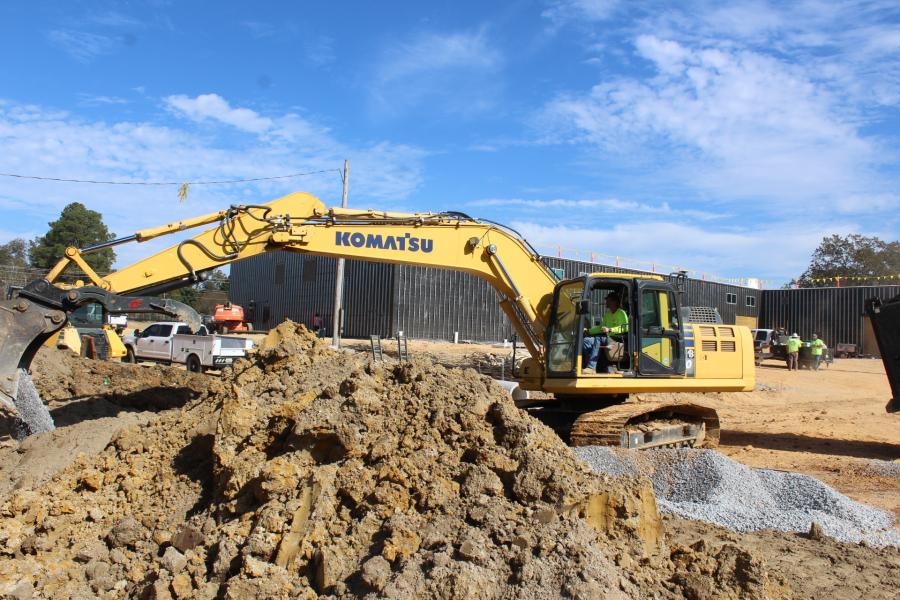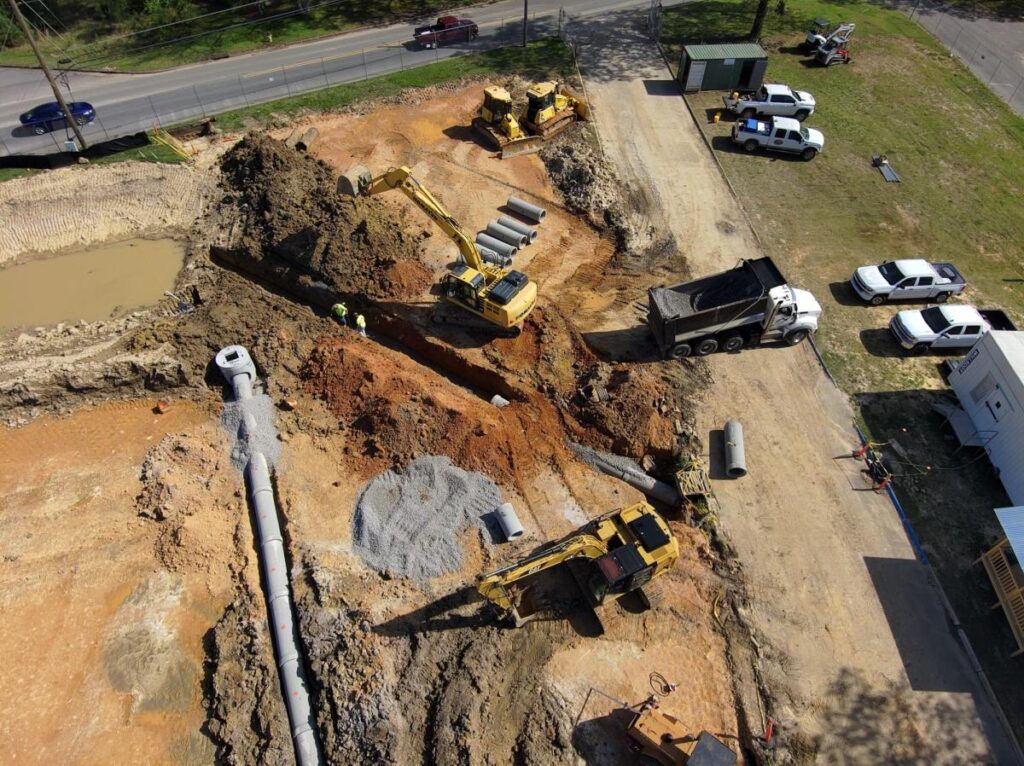All underground site utility work has now been completed.
(MJ Harris Co., photo)
In east Alabama, Gadsden State Community College is overseeing construction of its $24 million Advanced Manufacturing and Workforce Skills Training Center. The highly anticipated facility is being built on the East Broad campus.
“We are nurturing the next generation of engineers, technicians and skilled workers who will produce high quality, cutting-edge products,” said Alan Smith, dean of workforce development of Gadsden State.

“The Center is more than just a facility. It’s a catalyst for community transformation. It will equip individuals with skills, create jobs and propel the local economy. We’re not just building a skilled workforce. We are building a stronger, more resilient community. It’s the cornerstone of growth, innovation and shared success.”
Smith noted that feedback has been extremely positive.
“We’ve gotten a great response from many people in our community, specifically from industry leaders who will benefit from workers trained at the center. Investing in this center ensures that our local industries will remain competitive because we are providing them with workers who are equipped with skills that are needed to thrive in a rapidly evolving global market.”
The 50,000 sq.-ft. building will include 10 laboratories, seven classrooms, almost a dozen offices, a multipurpose room, 10 tool and storage rooms, a storm shelter, a testing suite, a kitchen and break room. It will feature glass viewing areas that allow prospective students and industry partners to have lab visibility during tours and will offer a digital display with information for job seekers.
The facility was identified as a needed project through the ACCS ASPIRE (Achieving Systemwide Potential through Increased Resources and Engagement) 2030 initiative, which provides funding for facility upgrades and new construction for all levels of education in Alabama.
In a news release, Gadsden State president Kathy Murphy said, “ASPIRE 2030 called on us to be creative, innovative and aspirational. It required us to think outside the box. Then, we burned that box, so we don’t put ourselves back in it.
“Gadsden State is proud of the engagement we had with local business and community partners in determining that we had a critical need for a facility that will provide our region with training in several high-demand, high-wage fields.”
Approximately 200 people attended the February launch of the project.
“The groundbreaking was an exciting beginning to what is sure to be a facility that will be a huge benefit to the communities we serve,” said Smith. “It was a day for us to be thankful and appreciative. It marked the beginning of a new era, where innovation and collaboration shape the future. With determination, vision and a united community, we are paving the way for progress and prosperity in our region.”
According to Vince Richardson, superintendent of contractor MJ Harris Co., “Unsuitable soils were the largest challenge on the site. Virtually the entire site was bad dirt, and we had to undercut it five to eight feet across six acres. This was a coordination challenge, with weather events and local traffic that surrounds the site.”
The job has involved moving 60,000 cu. yds. of import and export material. In addition to unsuitable soil removal and the haul in of new fill dirt, all underground site utility work has been completed.
“Currently, crews are installing the road base to begin curb and gutter work, and then asphalt paving for roads and parking areas,” said Richardson. “The construction and sequence of the different structural elements of the building have been the most challenging portions because there were four different parties involved with the building actually coming out of the ground. We had the slab on grade, structural steel, CMU block and hollow core panels that all create the structure of the building.”
Richardson said coordinating the different trades to maintain a steady flow of work was the most difficult part, because each played a crucial part in allowing the next team to begin its work on time.
“Also, a majority of the lab spaces are exposed structures, which creates contrasting colors and materials that will remain seen all the way to the completion of the building. This creates another challenge in ensuring that everything installed is of the utmost quality.”
While construction of the actual structure is the most time-consuming part of the job, Richardson said site preparation and coordination is crucial to performing the work efficiently and safely.
“With the mass undercut, we had to flow the work around the site in a manner that not only allowed the site subcontractor to stay productive, but also allow other subcontractors to begin their scopes of work. There were multiple pieces of heavy equipment, along with eight to 12 dump trucks in and out of the site for 12 hours a day that had to be coordinated. Ultimately, it was a success.”
Heavy machinery has included a dozer, smooth drum roller for base and a 210 excavator for backfill and removal of existing roadways. As for the weather, said Richardson, “Fortunately, we did not have a lot of major rain events during the early portions of construction, but as the months got warmer, the heat played a factor in productivity.”
For Richardson, the job is an opportunity to make a meaningful contribution.
“I, as well as the company I work for, take great pride in knowing that something we did will have a lasting impact for many years to come — not only to the students and teachers, but the community as well.”
Smith added, “This facility provides a modern, state-of-the-art space for students to train for high-tech careers that are in high demand with high wages. We will be able to expand our capacity so that we are able to serve more students. We will also be able to offer specific training that will support workforce development and economic development needs.
“We are modernizing our facilities and creating a training center that will create great change for technical dual-enrolled students, traditional college students, adult learners and students who need non-degree, short-term training.”
The expected completion date is late April 2024. CEG
Read the full article here

